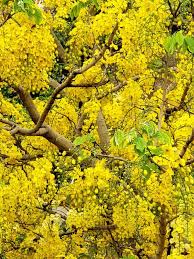Indian Laburnum:

According to SeasonWatch -a citizen science project that monitors tree phenology observed that over the last few years, Indian laburnum trees flowers have been blooming earlier than usual.
- Indian laburnum (Cassia fistula) is called “amaltas” in northern India and “kanikonna” in south
- It is a species of flowering plant in the Fabaceae family.
- It is also known as Golden Shower Tree, Amaltas, Purging Fistula, Pudding-pipe tree.
- It is native to India and is the State tree of Kerala and Delhi.
- It is a medium to large deciduous tree that can reach heights of up to 10 to 20 meters (approximately 30 to 65 feet).
- It is native to the Indian subcontinent, but it is also found in other parts of Asia, including Southeast Asia and the Middle East.
- It is a medium-sized deciduous tree that is leafless only for a brief time, between March and May.
- The new leaves are glossy, a trait that they lose on maturing, and are mostly bright green, though sometimes a rich copper too.
- It produces clusters of pendulous, cylindrical, yellow flowers that hang from the branches and bloom in abundance during the flowering season.
- It is commonly cultivated as an ornamental tree in tropical and subtropical regions worldwide.
- Its extracts from the bark, leaves, flowers, and seeds have been used to treat a variety of ailments, including constipation, skin conditions, digestive issues, and respiratory problems.
- Its bark is used to make dye and the pulp in the fruit pod also serves as a strong purgative agent, which helps animals that feed on it.




